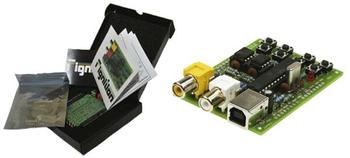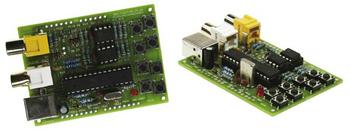Electronics retailer RS Components has launched a customised version of the small, low cost, self-assembly development computer board called the FIGnition inFUZE. The kit is aimed at people wanting to learn the basics of computing. The FIGnition inFUZE is based upon an 8-bit 20MHz ATmega328 microcontroller, supports a display up to 160 x 160 pixels and will have to be assembled by the buyer using their own toolkit; which should include a fine point soldering iron, side-cutters and long-nosed pliers. The computer system kit can be “soldered together in as little as one hour,” says the RS Components press release.
The FIGnition inFUZE is inspired by early 8-bit home computers such as the Sinclair ZX80 which is reputed to have given many of today’s electronics and computing engineers their first taste of hardware design. The kit is designed for construction by beginners with a few basic electronics tools. The computer is powered via a USB port and connects to either a PAL or NTSC TV to display a 25 x 24 text or 160 x 160 pixel bitmapped graphic image.
This 8-bit 20MHz computer is pre-loaded with the Forth programming language for users to learn and run computer code and a set of sample programs, including games and utilities, are supplied on the built-in 512Kbyte Flash memory chip. Programs run in the FIGnition inFUZE’s 8Kbyte of RAM (expandable to 32 Kbytes).
Specifications:
- 20MHz Atmel ATmega328 microcontroller, 32KB Flash memory, 2KB RAM, 1KB EEPROM
- On-board 512KB serial SPI Flash memory, expandable to 1MB
- On-board 8KB serial SPI RAM memory, expandable to 32KB
- Text display mode: 25 x 24 monochrome text with 16 user-defined characters
- Graphics display mode: 160 x 160 bitmap graphics with Sprite engine
- Pre-programmed FORTH language interpreter/compiler firmware, utilities and sample programs
- RCA jack (Yellow phono socket) for composite video display output
- RCA jack (Red phono socket) for audio output
- On-board programming keypad
- +5Vdc power supply via USB-B socket
- PCB footprint for optional I/O header sockets, Shield-compatible
- FIGnition has a GPL-open source software licence and is Open-Source Hardware OSH compliant
Users interact with the FIGnition inFUZE via its on-board eight-key keypad so no mouse or keyboard is required to supplement the kit. For getting information into the computer for analysis the device can also be connected to simple external sensors and data collected using the simple built-in 2-channel analogue data logger program.
“Building the FIGnition inFUZE from scratch is a great, interactive way for young people to gain their first hands-on learning experience of how computer hardware works,” said Jonathan Boxall, global head of semiconductors, RS Components. “Its low selling price makes it widely accessible and a valuable tool for educational purposes. It is one of a growing number of easy-to-use open-source development boards that provide a fun and useful introduction to computing to the engineers of the future.”
The FIGnition inFUZE SBC kit is available now for £32.99.








